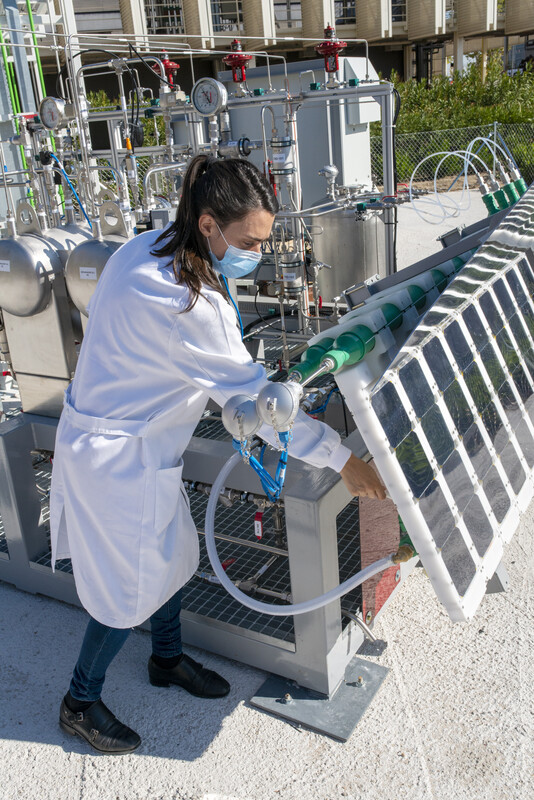Technological innovation has become indispensable in achieving decarbonisation targets in the medium and long-term. Many projects are underway to make our world carbon-neutral in the coming decades.
The effort made by Spanish companies is remarkable. Enagás has set itself the target of completely reducing its carbon footprint by 2040 through the implementation of more than 50 energy efficiency measures. But its contribution goes beyond that, promoting initiatives to achieve global decarbonisation. In its portfolio, a total of 55 specific renewable gas projects with more than 60 partners.
It is working together with Repsol on one of the most innovative projects to date: the development of a new technology that allows the direct transformation of solar energy into renewable hydrogen through a photoelectrocatalysis plant. It is a novel technology, since it does not need external electricity, just water and sun.
The project is already a reality. A pilot plant has been built and is operational and in production at the Repsol Technology Lab research centre in Móstoles. And progress is already being made in the scaling-up plans, with the construction of a demo plant to be started up in 2024 in Puertollano, with an area of around half a hectare and daily production of 100 kg of green hydrogen.
Technological innovation has become indispensable in achieving decarbonisation targets in the medium and long-term
In a follow-up phase, planned for 2028, the installation of a plant, already in the industrial phase, of about 60 hectares and with a production that reaches 10 tonnes per day, also located in Puertollano, is planned.
It was Repsol Technology Lab that began its research into photoelectrocatalysis technology in 2012, and a few years later, in 2018, Enagás joined the project with an agreement that makes the two companies co-owners.
Both companies agree that the particular advantage of this technology is that it simplifies the production process with respect to electrolysis, the most widely used option for the generation of green hydrogen.
In electrolysis, the energy to carry out the process comes from the sun or wind. And the renewable electricity generated is transported to an electrolyser where the water molecule is separated into hydrogen and oxygen.
Photoelectrocatalysis simplifies the production process with respect to electrolysis
Photoelectrocatalysis, however, integrates the process in a single step: “The device receives solar radiation directly and with a photoactive material generates the electrical charges that cause this separation,” explains María Dolores Hernández, co-leader of the project.
For Mónica Sánchez, Enagás’ Hydrogen Coordinator, “It is a highly disruptive technology, which is part of our commitment to renewable gases, specifically hydrogen and biomethane, as key elements in achieving the carbon neutrality that we want to achieve at European level, and specifically as a company by 2040”.
Competitive, large-scale production of renewable hydrogen for use as an energy source will be key to decarbonisation. Especially for its various applications as a source of thermal energy in mobility, intensive industry and power generation, and because it allows the management and production of renewable energy, transport and energy storage.
Competitive, large-scale production of renewable hydrogen for use as an energy source will be key to decarbonisation

The project is R&D with Spanish DNA and is spearheaded by a team of women from Enagás and Repsol. Some of Spain’s leading research centres have also collaborated in the project, such as the Catalonia Institute for Energy Research (IREC), the University Institute of Electrochemistry of the University of Alicante and the Hydrogen Foundation of Aragon, as well as an engineering firm specialised in innovative solutions, Magrana.
“The project shows a commitment to women researchers and is a clear example of the change in recent years in our role in large technological projects in the business world”, says Mónica Sánchez, who holds a PhD in chemical engineering.
The project is R&D with Spanish DNA and is spearheaded by a team of women from Enagás and Repsol
It has also had the support of the European Commission (EC) for some months now, which has approved part of its financing through the European Innovation Fund, a stimulus for its implementation.
The investment so far amounts to 8 million euros and both companies own the industrial property of this technology, which has resulted in 65 patent applications in more than 30 countries around the world, of which 40 have already been granted. For Ana Martínez, a researcher at Repsol Technology Lab and one of the leaders of the project, “This is an example of the innovation that this technology represents.”
Enagás is aware of the essential role that the company can play in the integration and implementation of renewable hydrogen in the energy system. Hydrogen that can be transported through the existing network for distribution to the different consumption points, thus allowing the current infrastructure to be used as energy storage for renewable electricity generation.
“Spain, due to its strategic location, is expected to be one of the future exporters of renewable hydrogen to other European markets that do not have this potential in solar energy. Here the gas infrastructure will be key to transport this gas”, says Mónica Sánchez.
Spain is expected to be one of the future exporters of renewable hydrogen to other European market
Enagás is involved in 55 renewable gas projects (34 green hydrogen and 21 biomethane projects).
All of them meet some common criteria: to help decarbonisation, especially in the territories most affected by the energy transition; to be tractors throughout their value chain; to contribute to the development of Spanish industry; to generate sustainable employment and they must be carried out in collaboration with partners.